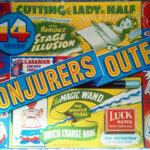A writer’s real work is the endless winnowing of sentences, The relentless exploration of possibilities, The effort, over and over again, to see in what you started out to say The possibility of something that you didn’t know you could. All too often a sense of magic is lost in the process of studying magic.
Corbett, P., Compton, A. K., & Pooley, W. G. (2022). Creative Histories of Witchcraft: France, 1790–1940. Cambridge University Press; Cambridge Core.
Some notes from the project
I wanted to experiment with ideas around turning contemporary accounts of the event into a form of witnessing. The source text for this experiment was a newspaper report recounting the Davenports ill-fated visit to Huddersfield in 1865.
This wasn’t the first time I had worked with this text. I had used it to develop a draft script that recounted the events of that night in a more traditional format. This script was subsequently published in the first issue of The Penny Mysteries (Taylor, 2018) and forgotten about.
Cultures of Place afforded the opportunity to work a little more closely with the source. This time I wasn’t so interested in a straightforward scripted adaptation of the piece, but I was more interested in understanding the event as witnessed by the journalist on the day (the only full first-hand account I can find so far).
The source is, of course, a written piece not a verbatim statement or even perhaps a credible witness, it is a piece of journalism – falling into the category of performative writing.
This approach is based on work published in (Corbett et al., 2022) where we have a call to ‘…embrace creative research methods and alternative ways of presenting histories…’ that ‘explores a different set of imaginative techniques to address the fundamental challenge of understanding magic in the past’. Note, when Corbett et al. are discussing ‘magic’ they mean real magic or witchcraft, while here I’m using it as an approach to an account of performance magic, or at least, in this case, in a form that was ambiguous in its attempt at representation.
I wanted these approaches to be an experiment in finding new perspectives on a this already performative representation of a past event, moving toward a creative intervention that allows you to see (creatively) 360 degrees into the past. The point being that I could use this new-found process to act as a remembering in order to devise a performance of a witnessing of the event.
My approach was to borrow techniques from areas identified by Corbet et all – specifically, Fidelity, Brevity, Performance, Empathy, the emphasis as I was entirely new to this approach was to be as playful as possible. This included written responses and practical responses such as repeatedly telling the story to camera, recounting, and occasionally mis-recounting, the events of that night.
The final result was the devising of a performed witnesses statement that, while mostly accurate to the events, inevitability succumbed to the creative process of the imaginative techniques applied.
This one-minute video is a cacophony of that process.


Comments by Nik Taylor